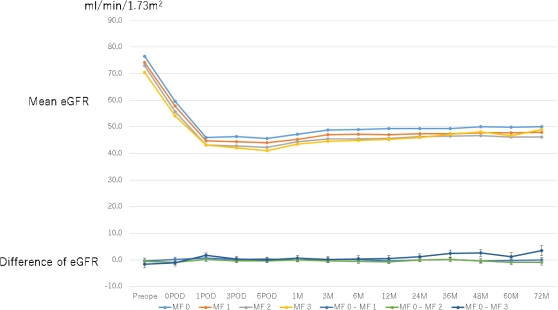The Impact of Marginal Factors on Postoperative Kidney Function of Complex Living Donors for Kidney Transplantation
Transplant and Endocrine Surgery, Nagoya Daini Red Cross Hospital, Nagoya, Aichi, Japan.
Meeting: 2018 American Transplant Congress
Abstract number: B156
Keywords: Donors, Glomerular filtration rate (GFR), Kidney transplantation, marginal, Risk factors
Session Information
Session Name: Poster Session B: Kidney Living Donor: Long Term Outcomes
Session Type: Poster Session
Date: Sunday, June 3, 2018
Session Time: 6:00pm-7:00pm
 Presentation Time: 6:00pm-7:00pm
Presentation Time: 6:00pm-7:00pm
Location: Hall 4EF
Background
Recently, complex living donors with marginal factors including hypertension, dyslipidemia, glucose intolerance, and obesity are increasing. Postoperative kidney function of living donors for kidney transplantation is of our great concern. We investigated the impact of the numeber of marginal factors on pathological findings of control biopsy and postoperative kidney function evaluated with estimated glomerular filtration rates (eGFR) of the living donors.
Methods
Between January 2008 and December 2016, 805 living donor kidney transplantations were performed at Nagoya Daini Red Cross Hospital. Eight hundred living donors were followed up more than 6 months after donor nephrectomy and included in this study. Marginal criteria for complex living donors include hypertension (>140/90 or treated with medications), dislipidemia (LDL cholesterol > 140, Tryglyceride > 150, HDL < 40 or treated with medications), glucose intolerance (impaired fasting glycemia, impaired glucose tolerance, or diabetes mellitus treated with medication within the range of HbA1c < 6.5% and albuminuria < 30mg/g・Cr), and obesity (BMI>30 kg/m2). Living donors were stratified into 4 groups with the number of marginal factors (MF 0,1,2,and 3). 214, 303, 196, and 89 living donors were classified into MF 0, MF 1, MF 2, and MF 3, respectively. Pathological findings of control biopsy and postoperative eGFRs in each group were compared between complex living donors with marginal factors (MF 1,2,3) and healthy living donors without them (MF 0), retrospectively.
Results
In pathological findings of control biopsies, obsolescent glomerulus or arteriolosclerosis were identified significantly more in the complex living donors with 3 marginal factors (MF 3) than healthy living donors (MF 0), (MF 0vs MF 1, MF 2, MF 3: P=0.634, 0.064, 0.0047). In postoperative eGFRs, no significant differences were identified in each point of observation period.
Conclusion
Postoperative kidney function of complex living donors can be maintained, when they are followed up closely.
CITATION INFORMATION: Hiramitsu T., Futamura K., Okada M., Tsujita M., Ichimori T., Goto N., Narumi S., Watarai Y. The Impact of Marginal Factors on Postoperative Kidney Function of Complex Living Donors for Kidney Transplantation Am J Transplant. 2017;17 (suppl 3).
To cite this abstract in AMA style:
Hiramitsu T, Futamura K, Okada M, Tsujita M, Ichimori T, Goto N, Narumi S, Watarai Y. The Impact of Marginal Factors on Postoperative Kidney Function of Complex Living Donors for Kidney Transplantation [abstract]. https://atcmeetingabstracts.com/abstract/the-impact-of-marginal-factors-on-postoperative-kidney-function-of-complex-living-donors-for-kidney-transplantation/. Accessed December 29, 2025.« Back to 2018 American Transplant Congress
